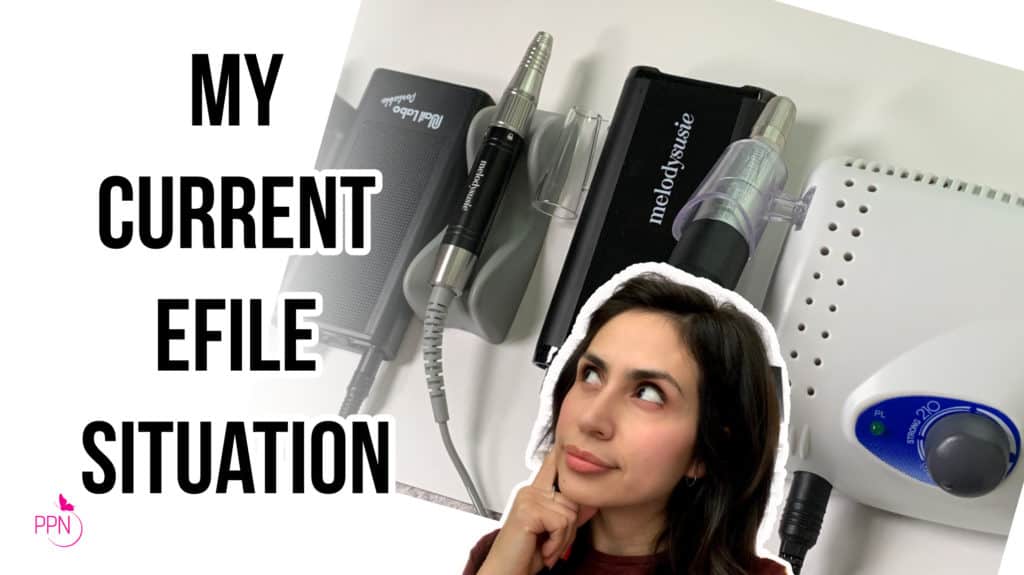Real quick announcement! …
We have a very special guest in this season of Kokoist Japanese Gel Certification.
This season you’ll have the opportunity to upgrade your enrollment with the queen of efiling herself, Hilary Dawn Herrera.

Look forward to that in this week of early bird enrollment. Get on the waitlist now, so that you don’t miss any announcements, including early bird enrollment perks.
Now on to today’s topic! …
___
In the period where I was figuring “my thing” out in nails, I was undecided as to what bits to commit too.
I kind of grew up seeing the paper sanding band at most salons, and so inevitably, as a newbie nail tech, I started with that.
Metal bits freaked me out because of the precision I had to have to not cut or burn a client, or even avoiding my natural nail with them when doing my own nails was stressful.
A few times I’d shave just a little chunk off which would lead to a horrible burn when curing my gel nails. This literally lit a little fire under my fingers to nail this efiling thing.
We want to keep as many layers of our natural nails as possible, especially when curing gel nails as our keratin is very important to shield us from curing heat and nail chemicals. And that is because our nail plates are actually very impermeable to chemicals.
It wasn’t until I started seeing clips of these pink ceramic bits that I felt safe with my efiling and with any material I used.
There is a place for every material type of efile bit (ebit), but today I want to focus on explaining the differences between carbides and ceramics to help you decide which is best for gel nails. There is actually room for both.

We’ll start by comparing both materials, carbide and ceramic bits, including pros and cons.
At the end I’ll share what I use and teach my students about their use of soft gel nails.
Similarities in carbides and ceramics
One predominant similarity between tungsten carbide bits and ceramic bits is that both are similarly durable when under heat and pressure stress.

Image source: cutlery.kyocera.com
As you can see in this MOH’s Hardness scale, which in a gist, measures a mineral’s resistance to scratching or wear, you can see that tungsten, and ceramic are at the top of the scale.
For the sake of today’s topic, when I talk about carbides, I will specifically be referring to tungsten metal carbides, unless I note otherwise.
Another similarity is that both carbide and ceramic bits can come in different colors. Carbide metal bits will be plated, while ceramics are through and through the same color externally as they are internally.
Let’s start with carbide…
Carbide e-bits are metal.

The most popular you will see are titanium and tungsten carbides; with tungsten being significantly stronger or more durable than titanium.
And it seems, in my quick research of the materials, that because Tungsten is more resistant under pressure and heat stress than titanium carbides, tungsten carbide is the material most ideal for removals- whereas titanium carbides are going to be better for things like finishing enhancements.
The pros and cons to either option are actually minor, but I embrace the nail nerd in you and I, so let’s look into these.
PROS of using carbide ebits
- Carbides out of all other materials for ebits will remove product faster.
- That ‘s just the nature of the carbide material, which is why if you make a boo-boo on the natural nail, it is a significant one, even though you just barely touched the nail.
- Carbide is slightly more durable.
- Either option though will require replacement around the 3 month mark- depending on use
- Carbide is an excellent choice for hard products like acrylic, hard gel, or acrygel products.
- Because of the nature of the product, as discussed earlier, it shaves product effortlessly.
CONS of using carbide ebits
- Carbide is more prone to heating than ceramic.
- Carbides are metals that are good conductors of energy; in this instance, that energy is in the form of heat. With that being said, both will conduct friction heat while spinning at thousands of RPM, but again, metal will get hotter faster. Keep this in mind as you’re working on clients. Whatever option you use, you’ll want to move swiftly through each nail.
- You must work at high RPM (rotations per minute) when using tungsten carbide.
- Tungsten carbide is a hefty /weighty metal, to shave off product swiftly and smoothly, it needs a significant amount of speed. And so, it would not be uncommon to use up to the highest speed of your efile for removal. But only do this if you’ve gone through a course in efiling, as you may cause serious injury to your nail or nail matrix, which can be permanent.
- Carbides can be slightly more expensive.
- The difference is not significant, but if you are going through your carbides a bit too often, and you’re only working on soak-off products. It may be financially worth it to stick to ceramics.
Let’s now move on to the pros and cons of ceramic efile bits
PROS of using ceramic ebits

- Ceramic ebits are also great removal bits because of their hardness as discussed in the MOHs scale.
- Ceramic ebits generate less heat.
- Less heat generated on the nail is a benefit when doing gel nails because this can potentially decrease heat spikes on nails while in the curing unit.
- An already warm nail bed will only get hotter during curing; ceramic is essentially clay, like porcelain. And if you’ve ever handled a clay pot or a porcelain dish, you can feel its coolness. And so it takes a little more time and energy to heat up clay than metal.
- Also, the finer or more worn down your flutes are (the teeth of your bits), the more heat can be experienced on the nail. So please keep track of your bits, especially when you use them consistently on clients.
On yourself, you’ll probably need a set of bits, once or twice per year.
- Ceramic allows you to work at variable speeds and still remove product effectively.
- Ceramic is more lightweight than carbide, so it does not require the same intensity in speed to shave off product. Its more glass-like lightweight-feel is what allows it to shave product so delicately just about at any speed.
- This makes ceramic removal bits super beginner-friendly, allowing users to work at a lower RPM while they confidently work their way into a higher RPM.
- Ceramic bits can be used on the natural nail plate.
- Ceramic bits are commonly used to remove cuticle from the nail plate. Still, even when they accidentally touch the nail plate, the contact is not detrimental, as the ceramic delicately shaves down any material, including keratin. Obviously, only fine-medium grits should be used on the natural nail. And that, sparingly. A coarse-grit ceramic will most definitely remove a significant amount of keratin.
- Cases where you might use ceramic over the natural nails are nail imperfections or complete product removals. This should only be done after proper training. You CAN and will thin down your natural nails with improper use.

- As we alluded to earlier, ceramics are often a few dollars cheaper than your carbides. So, if you’re not often removing bulk on nails, you can save a few dollars by only sticking to ceramics.
CONS of using ceramic ebits
I’d say there are only two significant cons to ceramics
- Ceramics are not the ideal material for product removal of acrylic, acrygel, and even hard gel.
- This is because usually these products apply much thicker than your soak-off products, and so to get through the bulk efficiently, it’s better to use the heavy duty option, i.e. your Tungsten Carbide
There are coarser grits for ceramics, but not only do the flutes start looking kind of mean, but also, in my experience, they don’t feel as smooth as a metal carbide at the same grit.

- Ceramics are not easy to find with a lot of distributors.
- Unfortunately, because there is a bit of education lacking with ceramics, a lot of people including nail techs and distributors don’t know all of the awesome features of ceramics, so they cater their offerings to the demand for metal bits… because that is what most techs know
But now that you know how cool they are, no pun intended, you can request your distributor to start carrying them. You’ll be surprised sometimes they just need to see and hear just enough demand to make the effort to carry them.
Personally the pros for using ceramics significantly outweigh the cons for me as a specialized soft gel stylist.
I often use and teach my students to use both as specialized soft gel stylists.
We use a carbide to remove the bulk quickly and then transition to a fine or even extra-fine ceramic to flush the product as flat to the natural nail, and because that bit is ceramic we alleviate any panic of touching the natural nail with the bit.
Conclusion
Well there you have it, carbide vs ceramic. It’s just a matter of selecting the right tool for the right job.
The biggest benefit to using ceramic bits with your gel nails is that they will help keep the nail beds from heating up. This is important so that the mechanical (friction) heat the bit is causing on the nail bed/plate does not accumulate with that heat that happens when the gel nails are curing.
If you would like further support and learn more about efiling with me, I’d love for you to join me inside my Efficient Efiling Masterclass (Save $50 with code “ebits-blog”). EEM is my step-by-step digital course on all of my salon efiling techniques.

My favorite sources for efile bits are the following:
- Exclusive Nail Couture
The first bits I ever started with! This is the only source I know that has Zirconia Ceramic Bits!
- Daily Charme (code PPN10)
DC specifically stocked the four bits I use the most! (How nice of them!)
- MelodySusie (code PPN10K)
- Nashlynails (code PPN10)
- Nail Labo (code PPN10)
Thank you for watching, feel free to drop any comments below, and I’ll see you next week. Bye for now!

Content written by Paola Ponce
Loved this blog? Then I think you’ll love learning more about my journey as a specialized gel nail solopreneur in the nail industry. Click here to get instant access to my free masterclass. These blogs are copyrighted material, and any use of this blog is not permitted without written concern first. Some of these blogs contain affiliate links that give us a small commission when qualifying purchases are made. Thank you for being so supportive, which helps us to continue creating valuable resources and content like this.


